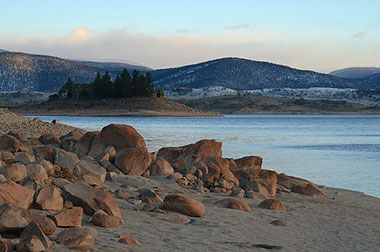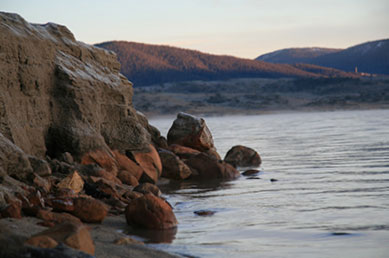For photographers who use SLR cameras, AV or A mode determines whether all the photograph is in focus or part of. For example photographers can choose to have a sharp foreground and background, or they can blur the background. If you’re after more technical details, Wikipedia already has a great article on how aperture works in photography.
On digital SLR cameras, aperture is indicated by a f-number value.

On the other hand if you’re taking a photograph of a bird and you want the animal in focus but not the background, then you would choose a small F number like F/4.
You can see what aperture your digital SLR camera is set at by looking at the back LCD screen for a F number. As you can see by the image above right, the aperture in that example is set at F4.0. The display shown on your LCD may look different to this example, depending on the make and model of your camera.
How to set your camera to aperture priority?

Once you have AV mode turned on, you can change the f-number by rotating the main dial above the shutter button. Note: this is for Canon digital cameras. You may need to refer to your manual to find out how to change the F stop for your specific brand of camera.
When the f number is small, the lens diaphragm is actually wide open. So if someone says to you that you need to open your lens more, they mean to lower the aperture or F number. Alternatively, if the aperture is a large number, say F22 then the lens diaphragm is smaller or more closed. This often causes much confusion with beginners.
- Opening your lens more refers to lowering the f number.
- Closing your lens more refers to a higher f number.
The best way to understand how aperture works is to take numerous photographs with different f-number values and see what the difference is.
Take images at both ends of the scale. One with as low a F number as possible and one with as high a F number as possible. More importantly, when you view them on your computer take notice of how much of the photo is in focus.
Shown below is a couple of examples I’ve done myself to help explain aperture.
In the first photograph shown below, the aperture (f number) was set at f/11 so all the image is in focus.
Now for the second photo, the aperture was set at a smaller number f/5.6 so only the rocks and sand at the foreground are in sharp focus while the background elements are blurred.
And here is an example of a close object photographed with an aperture value of f/5.6. As you can see the foreground object is in sharp focus and the background is blurry.
It’s also important to note that results from aperture settings can change from one lens to another. For example just because an aperture value of f/5.6 for your macro lens results in a blurred background, it doesn’t mean you should also set your telephoto or wide angle lens to the same f stop. Therefore its important to experiment with all your camera lenses so you know your equipment better.
All photographs shown on this page are taken with a Canon 400D (Rebel XTi) Digital SLR Camera.
Photography Assignment – Grab your DSLR camera and give this a try
Understanding how each mode works separately, is vitally important before trying M (manual mode). Learn how to use aperture priority and how different F numbers effect the overall image. Then and only then, will you fully understand how to use it when shooting in manual (M) mode.
Assignment: Lesson in aperture priority mode
- Set your digital SLR camera to aperture priority mode. For Canon users, this means turning your mode dial to AV. Nikon users need to change the dial to the letter A. If you don’t see the letters AV or A, then refer to your camera manual.
- Change your camera’s aperture F stop to the lowest number possible for your lens. It’s important to note that each lens will be able to shoot at different apertures. Expensive lenses can go as low as F1, where most on average will be able to shoot at around F4.
- Go outside and photograph a close object where the background elements are far away in distance. This is extreme to ensure you easily see the visual differences as you change the F number. On a low F number, you should notice the background is very blurred, when compared to the main object that is in focus.
- Now change the aperture number to around F7.1 and take the shot again.
- Take two more photographs, firstly with an aperture of F11, and then F22.
- Download and open all 4 photographs on your computer and see the difference that can be seen in the background. Notice the lower the F number, the more blurred the background. The higher the F number, the more of the background that is seen in focus.


